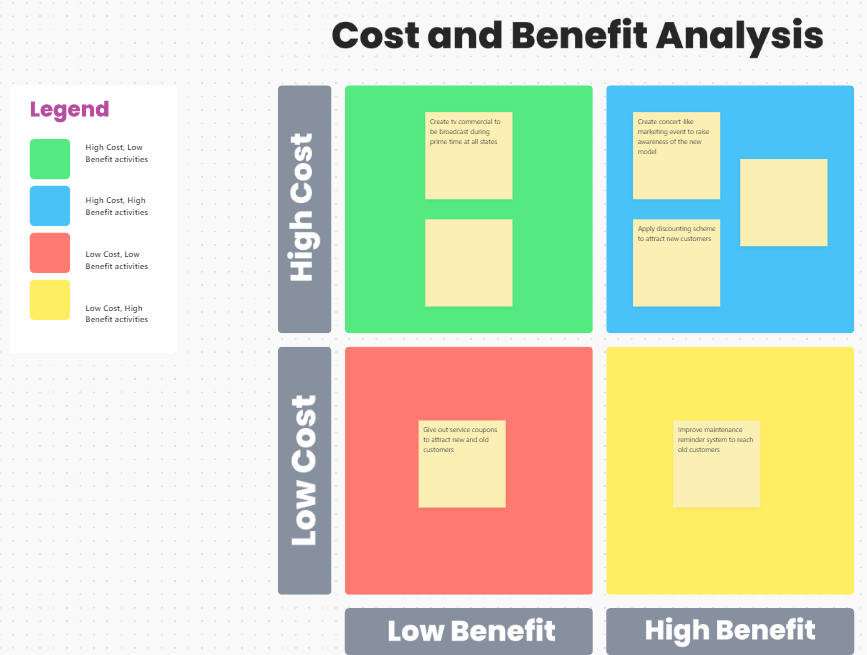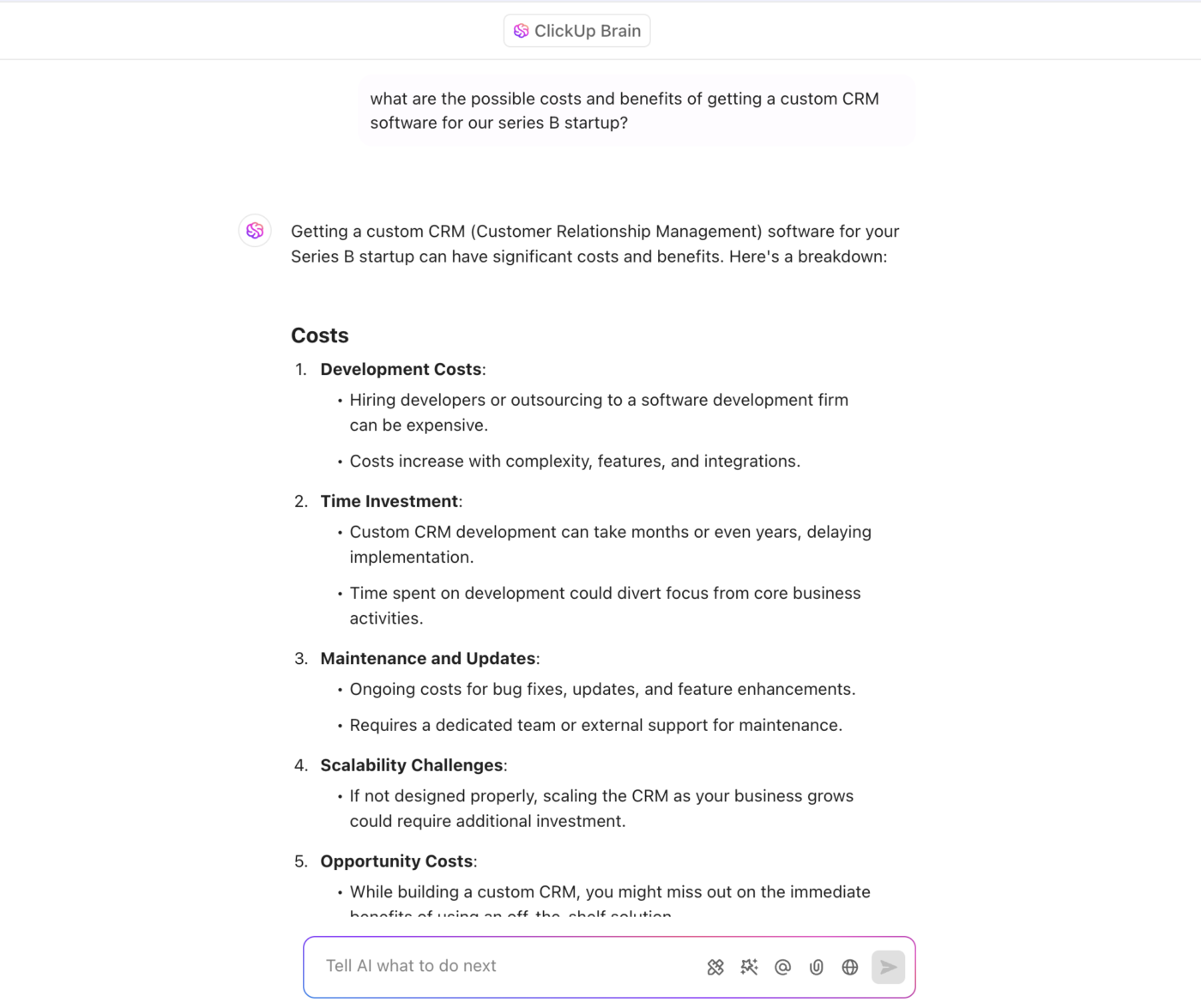10 Free Cost-Benefit Analysis Templates

Sorry, there were no results found for “”
Sorry, there were no results found for “”
Sorry, there were no results found for “”

The revolutionary idea of cost-benefit analysis broadened the understanding of ‘profit’ for businesses.
Rather than focusing purely on the net expected costs and the monetary value of benefits, it offered a multi-dimensional understanding of perceived value.
This brought to light scenarios where the benefits outweigh costs due to intangible benefits or gains like social good, brand building, etc.
Even though the concept dates back to the late 1840s, this comprehensive economic impact analysis continues to clarify whether a decision or action is worth pursuing.
Modern-day cost-benefit analysis processes have evolved to gain more structure while methodically comparing the costs incurred and the anticipated benefits for a decision or action item.
We take a look at some cost-benefit analysis templates that embody this quality.
Cost-benefit analysis (CBA) is a systematic approach to evaluating the financial and non-financial impacts of a project or decision. It involves comparing a project’s expected costs against its anticipated benefits to determine whether it’s worth pursuing.
By assigning monetary values to both costs and benefits, CBA helps project managers and decision-makers assess a project’s overall value and prioritize resources effectively.
In essence, cost-benefit analysis is a critical tool for project managers. It helps them balance aspirations with practicality and ensures that projects deliver tangible results.
A cost-benefit analysis template is a structured document or spreadsheet for businesses or individuals to assess the cost and benefits of a project, expense decision, or investment. Think of it as a preconfigured tool to systematically evaluate whether the benefits of a proposed action or decision justify the associated costs.
Read more: How to calculate project ROI
Knowing the right timing to use a cost-benefit analysis template can be crucial for making informed decisions for your business. Here are some scenarios when deploying these templates may be highly beneficial:
When conducting a cost-benefit analysis, it’s essential to identify and categorize all relevant costs and benefits, ensuring nothing significant is overlooked. These can generally be divided into tangible and intangible factors.
Conducting a cost-benefit analysis (CBA) involves breaking down the process into clear, actionable steps. Here’s a step-by-step guide to help you approach it systematically:
Start by clearly identifying the project, initiative, or decision being analyzed. Outline the scope, objectives, and timeline to establish boundaries for the analysis.
Let’s take the example of a company deciding whether to implement a new customer relationship management (CRM) tool to improve sales efficiency.
List all direct, indirect, fixed, variable, and opportunity costs associated with the project. Once these are all documented, identify direct, indirect, tangible, intangible, and strategic benefits as well. Remember to involve stakeholders to capture hidden or overlooked factors.
Example costs:
Example benefits:
Use a spreadsheet or project management software like ClickUp to outline these costs.
You can also ask ClickUp Brain, ClickUp’s native AI assistant, to brainstorm the costs and benefits of a project with you and get smart suggestions tailored to your org.

Quantify all identified costs and benefits in monetary terms, even intangible factors like employee satisfaction (e.g., by estimating their impact on productivity).
Use market research, historical data, or expert judgment to estimate values accurately.
For example, if the CRM tool reduces manual data entry by 20%, calculate the savings in employee hours and translate that into a dollar amount.
Projects often span months or years, so it’s crucial to factor in the time value of money.
Use Net Present Value (NPV) or Discounted Cash Flow (DCF) to adjust future costs and benefits to their present value. Select an appropriate discount rate, typically based on the cost of capital or industry standards.
The formula for Present Value (PV):
PV=Future Value(1+r)tPV = \frac{\text{Future Value}}{(1 + r)^t}PV=(1+r)tFuture Value
Where:
Sum up the total costs and benefits, then calculate key metrics to evaluate the project’s feasibility:
Test how changes in assumptions (e.g., cost estimates, discount rates) impact the results. This helps account for uncertainties and identify critical variables that could influence the decision.
Present the results in a clear, concise report.
Include a summary of costs and benefits, key assumptions, sensitivity analysis outcomes, and your recommendation. Highlight risks and mitigation strategies to support decision-making.
With a BCR greater than 1, the project is likely to deliver a strong return on investment.
Utilizing project management software for your cost analysis allows for better tracking, visualization, and automation of the process. Let’s look at how you can use templates and project management tools to simplify cost-benefit analysis.
As you’ve seen, a cost-benefit analysis is not an easy task. That’s why we love cost-benefit analysis templates!
Now that you have a basic understanding of a cost-benefit analysis template and its underlying components, let’s dive into a few templates that can power effective project management:
The ClickUp Cost-Benefit Analysis Template is a highly versatile tool designed to assist financial analysts in evaluating the financial implications of key business decisions. Use this simple cost-benefit analysis template to reach strategic decisions, like whether to launch a product or invest in project management tools and how they will benefit your business.
Some key features of the ClickUp cost-benefit analysis template include:
Ideal for: Analysts looking for a template that supports collaborative working, integration with AI and automation, and continuous monitoring and analysis to improve decision-making.
The ClickUp Cost Analysis Template is necessary to monitor financial health, streamline processes, and make them financially viable. It takes a comprehensive look at the project’s cost —including the direct costs and indirect costs. In addition to the standard features of custom statuses, fields, and views, this template also offers:
Ideal for: Insight into areas for cost reduction and possible roadblocks to cost efficiency, which can be instrumental in maintaining business profitability and maximizing benefits.
If your organization is involved in the production process of products or services, then the ClickUp Production Cost Analysis Template is an invaluable asset. This cost-benefit analysis goes beyond traditional cost analysis by factoring in all the costs, like labor costs, opportunity costs, etc., that go into production. This quality makes this cost-benefit analysis template useful for building complete project budget proposals.
Some of its key features include:
Ideal for: A systemic approach to your production cost analysis to help you make informed decisions.
The ClickUp Project Cost Analysis Template is essential to every project manager’s arsenal. It offers a reliable framework for project managers to track and analyze project costs to maintain profitability. It makes project management more data-driven with the following offerings:
Ideal for: Maximizing financial benefits from the project planning stage.
As the name suggests, use the ClickUp Monthly Expense Report Template to document, track, and analyze monthly expenses. This template is helpful as a process standardization tool as you monitor all tangible and intangible costs month after month.
Some of the key features and benefits of this template include:
Ideal for: Monthly expense tracking and management of projects
While running a large business or an enterprise, tracking all expenses made by different teams or team members can be challenging. The ClickUp Business Expense and Report Template streamlines the process of tracking, managing, and reporting such company expenses.
It offers the following:
If you’re looking for a cost-benefit analysis template that tracks company expenses, offers savings opportunities, forecasts future costs, and enforces compliance, this Business Expense and Report template is the way to go.
Ideal for: Maintaining compliance with any financial regulation.
The ClickUp Project Cost Management Template is another indispensable tool for project managers to track and manage expenses across various projects. Designed by the experts at ClickUp, this template grants real-time visibility, performance visualization, and optimization insights for project cost management.
Its key features include
Ideal for: Project managers looking for a versatile project cost management template for various projects—from software development to construction, manufacturing, and more!
Track project costs, roadblocks, and outcomes in one place with a custom project management dashboard. Learn how to build one using this quick video explainer 👇🏽
While the Expense and Report template discussed previously was more aligned with the requirements of large businesses and enterprises, this ClickUp Expenses Report Template is for businesses of all shapes and sizes. You can even use this template for personal finance management to track your expenses.
As a centralized platform for comprehensive expense tracking and management, this cost-benefit analysis template has the following to offer:
Ideal for: Small businesses and individuals looking to increase profitability.

The Excel Enterprise Cost Analysis Statement Template from WPS Template is a comprehensive tool to manage and dissect all the costs across different operations and departments within your enterprise. Available as an Excel template, this cost-benefit analysis template offers structure to your cost-benefit analysis activities and makes all expenses traceable and accountable.
The template also translates all the calculations and findings into interactive bar graphs, pie charts, and other visual forms to represent the enterprise’s financial health.
Unlike the different templates discussed above, this offers limited customization.
Ideal for: Simple cost-benefit analysis.

This Excel Cost-Benefit Analysis Template is another option to consider if you prefer to use Microsoft Excel in project planning and cost-benefit analysis. It is a highly visual template that automatically converts all the entered data into visual elements like graphs, charts, etc., to make all the financial reports easy to comprehend.
This template replicates a dashboard that visually depicts all the cost-benefit analysis parameters, such as the different cost categories, monetary value of cost, direct and indirect benefits, etc.
Unfortunately, due to the limited scope of Excel spreadsheets, you cannot extract additional features like project management abilities like the ClickUp templates.
Ideal for: MS Excel users who need to do a basic cost-benefit analysis.
A good cost-benefit analysis template carries different sections and elements to facilitate granular analysis. Some basic cost-benefit analysis template components include:
Cost-benefit analysis is widely applicable across industries and decision-making scenarios. Below are some practical examples:
By analyzing these costs and benefits, project managers can prioritize initiatives, ensure efficient resource allocation, and achieve better outcomes.
That’s a wrap on cost-benefit analyses. Use the above free tools responsibly to convert project ideas into financially viable business models, attracting an array of benefits. Configure these templates to match your requirements to convert business opportunities and reduce a project’s costs.
Also, if you’re looking for a one-stop cost-benefit analysis tool equipped with powerful project management features and cloud-based functionality, then ClickUp is the perfect option.
From remote accessibility to a user-friendly interface to real-time analytics, the platform takes regular cost-benefit analysis to a new plane. Schedule a demo or just sign up for a free ClickUp account to discover more.
© 2025 ClickUp